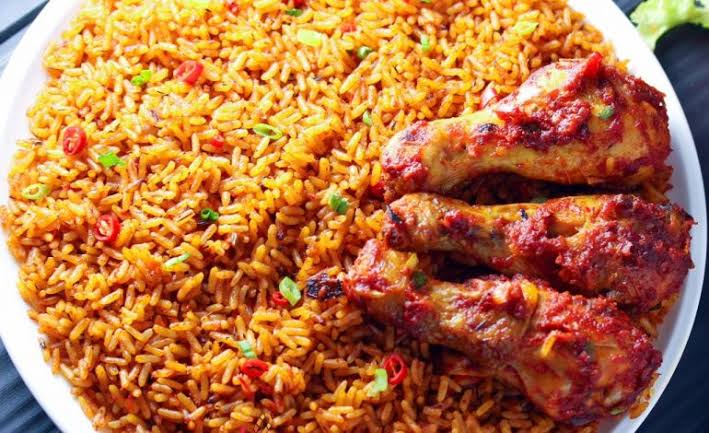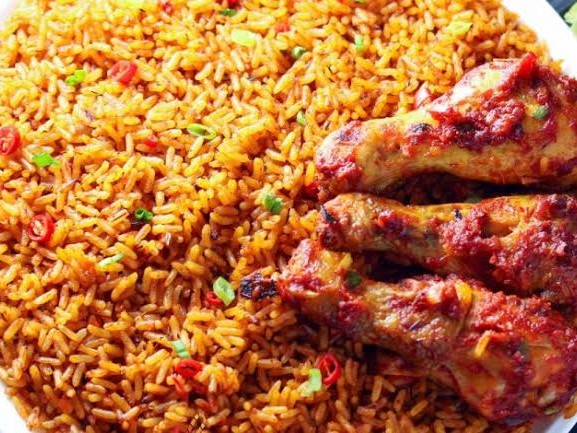Share this!
Know the Differences Between Nigerian and Ghanaian Jollof Rice
Any one in West Africa knows there is a great debate between Nigerian and Ghanian Jollof rice. The debate is so serious that on Jollof Rice Day (August 22), Nigerian and Ghanian Jollof rice are sampled to decide which tastes better. Interestingly, no one has given a definite answer as to which Jollof rice tastes better.
Ghanaians say the grains in Nigerian Jollof rice are too fat and tasteless. Nigerians say the grains in Ghanian Jollof rice are too starchy. Nigerians are a bit forward and loud in their debate. On social media, they use a lot of videos, memes, gifs and pictures to throw a lot of shade on Ghanaian Jollof. Sometime in 2016, they even tried to get Facebook owner Mark Zuckerberg decide which Jollof tastes better. Hilarious!
The Ghanians are more on the defensive, trying to block and counteract the attack from Nigerians on social media. You won’t blame them. With the ferocity of attack they get from Nigerians on social media, it’s pretty easy to think Nigerian Jollof rice tastes better.
Surprisingly, Jollof rice didn’t originate from any of these two noise makers. Ouch!
Origins of Jollof Rice
Jollof rice originates from Senegal and the Gambia where the Wolof people of that region invented the dish. No wonder Jollof sounds similar to Wolof. The Wolof people were also called the Djolof or Jolof tribe.
It is believed that Jollof was invented by a woman who lived near the Senegal river delta. It is said that this woman substituted rice for barley during a barley shortage. Using rice, fish, vegetables and tomatoes she created a tasty dish which was called Jollof.
The Senegalese also have another name for this dish, Thieboudienne. In Gambia, it is called Benachim (One pot). The Jollof recipe travelled from Senegal to the Gambia, Mauritania then to other West African countries. The Ghanians amd Nigerians mastered the recipe, became experts and are struggling for copyrights.
A poll done in 2013 revealed that 40% thought Jollof originated from Ghana, 21% thought it originated from Nigeria, while 23% thought Jollof originated from Senegal. Thank God we know better.
Key Ingredients In Jollof Rice
Jollof rice is made with rice, tomatoes, tomato paste, onions, scotch bonnet peppers, salt, spices and vegetable oil. These are the standard ingredients. Other varying ingredients include assorted vegetables, and different types of local spices.

Nigerian Jollof Rice
The first key difference in Nigerian Jollof is the type of rice grain used. Nigerian Jollof is made with long grain parboiled rice. Long grain rice is not native to Nigeria, but imported from Asian countries.
A second difference is the method of cooking. The grains used in Nigerian Jollof have to be parboiled and washed a second time to remove the starchy content.
Party Jollof rice, is a popular trademark in most Nigerian parties and celebrations. This dish is legendary for its smoky taste. This dish is cooked over a fire wood and allowed to burn at the bottom to give it a smoky flavour. A significant spice used in cooking the Nigerian Jollof is the bay leaf, which also adds to its rich smoky flavour.

Ghanian Jollof Rice
Ghanian Jollof is made with basmati rice which is also known as Thai Jasmine rice. Basmati is a long slender grained rice with a higher starch content than the long grain parboiled rice. Basmati also has a characteristic aromatic smell. Like the long grain rice, basmati is not native to Ghana but imported from Asian countries, especially India.
The basmati rice is not parboiled. Parboiling makes it soggy. To prevent this, Ghanians prepare the tomato stew and meat stock and use that to cook the rice at once.
Ghanian Jollof rice is also more spicy than Nigerian Jollof. While Nigerians use bay leaf as a key spice, Ghanians use shito, an oily condiment made with hot peppers, ginger, shrimps and onion.
Unlike Nigerian Jollof, Ghanian Jollof rice doesn’t have a party version that is cooked over fire wood.
A Battle of Taste
So which Jollof tastes better?
Frankly we can’t seem to decide. Both dishes taste great and it will be unfair to rate a dish above the other. Why?
Both dishes are unique. Honestly we don’t think they can or should be compared.
However, we want to celebrate both countries for putting Jollof rice on international menus. Thanks to them, Jollof rice is the most popular local dish eaten internationally!
We encourage Nigerians and Ghanians to keep mastering the recipe of this irresistible dish.
Read more about Jollof Rice!
OR try these recipes: West African Jollof Rice & Seafood Jollof Rice!






